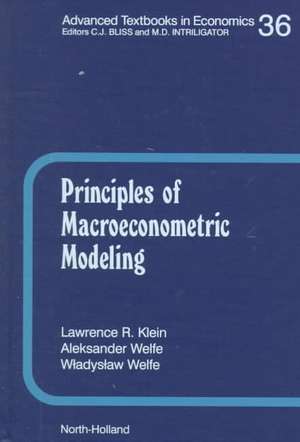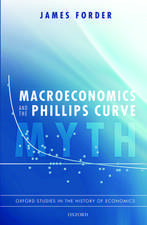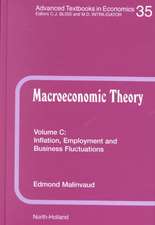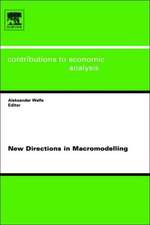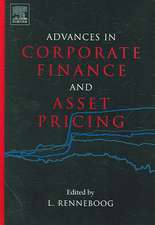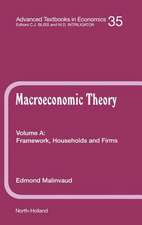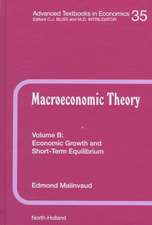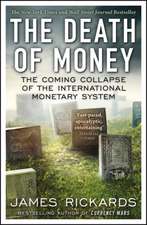Principles of Macroeconometric Modeling: Advanced Textbooks in Economics, cartea 36
Autor L.R. Klein, W. Welfe, A. Welfeen Limba Engleză Hardback – 29 sep 1999
These major events require reconsideration and redrafting of some of the materials of the original edition.
The present volume retains the original structure of "Lectures on Microeconomic Theory" and takes up principles of constructing dynamic macroeconometric models and their use in economic analyses and forecasting, while introducing many updates, revisions and extensions. The description of the econometric methodology has been limited to specific applications of time series analysis, and the title has been changed to "Principles of Macroeconometric Modeling".
The first four chapters discuss the principles of specifying equations of structural macromodels, covering both developed marked economies, transition economies and world-wide models. The remaining chapters cover some major issues in the use of macromodels. The point of departure is model simulation, especially of the prevailing non-linear models, which is followed by model validation. The analysis of model dynamics covers economic fluctuations and the relevant implications of non-stationarity. The use of macromodels in policy analysis is presented next; it includes multiplier analysis and scenario simulations. The monograph ends up with forecasting being a special case of simulation analysis.
Preț: 639.89 lei
Preț vechi: 831.03 lei
-23% Nou
Puncte Express: 960
Preț estimativ în valută:
122.46€ • 132.97$ • 102.86£
122.46€ • 132.97$ • 102.86£
Carte tipărită la comandă
Livrare economică 22 aprilie-06 mai
Preluare comenzi: 021 569.72.76
Specificații
ISBN-13: 9780444818782
ISBN-10: 0444818782
Pagini: 368
Dimensiuni: 156 x 234 x 21 mm
Greutate: 0.69 kg
Ediția:Revised.
Editura: ELSEVIER SCIENCE
Seria Advanced Textbooks in Economics
ISBN-10: 0444818782
Pagini: 368
Dimensiuni: 156 x 234 x 21 mm
Greutate: 0.69 kg
Ediția:Revised.
Editura: ELSEVIER SCIENCE
Seria Advanced Textbooks in Economics
Cuprins
Preface. Models of the Economy as a Whole. What is a model? A Macroeconomic model - a new approach. Another accounting system, input-output (I-O). Yet another accounting system, flow-of-funds (F/F). Models of the Centrally Planned and Transition Economies. The basic framework. Demand determined models. Supply determined systems: the supply side. Fully supply determined systems. Quasi-supply determined systems. Disequilibrium macromodels. The use of macroeconometric models. Major Topics in Macromodelling. Final and intermediate demand functions. Supply determination. Production functions and production potential. Price and wage equations. Financial flows. Project Link. The LINK Matrix. The LINK algorithm. Some LINK applications. New directions for LINK. Simulation. Formulas of simulation. The Gauss-Seidel algorithm: linear case. The Gauss-Seidel algorithm: nonlinear case. The Newton method. Stochastic simulation. Model Validation. Sources of error. Descriptive measures of error. Analytical measures of error. Some limits to accuracy. Dynamic Analysis. A theory of economic fluctuations. Some sinusoidal limit theorems for econometric models. Otsuki's sinusoidal limit theorem. Measurement - the spectral approach to the frequency domain. Measurement - an autoregressive approach in the time domain. Some interpretations of economic dynamics. New directions in time series analysis. VAR models. Stationarity and non-stationarity. Equilibrium relationships and cointegration analysis. Rational expectations. Multiplier and Policy Analysis. Multipliers. Some multiplier tabulations and policy simulations. Optimal economic policy. Forecasting. Ex ante prediction. Forecast preparation. The forecast horizon. Combinations of high and low frequency forecasts. Ex ante forecast error.
Recenzii
"...At a level suitable for graduate or advanced undergraduates in economics, explains the principles of constructing dyanmic macroeconometric models and their use in economic analyses and forecasting." --Scithech Booknews
